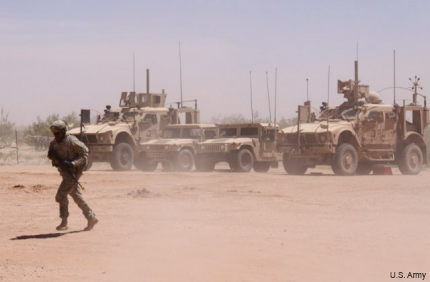Army's new war game to focus on tech, innovations
The service will replace one NIE a year with the more innovation-focused Army Warfighting Assessment.

NIE exercises have mostly focused on the tactical network.
The Army is shifting the way it develops new technologies for the battlefield, replacing one of the two annual Network Integration Evaluations with the broader Army Warfighting Assessment, which will focus on innovation and developing partnerships with industry and academia.
The service recently issued a sources sought notice looking for potential candidates to take part in the next AWA, scheduled to begin Oct. 17, 2016. Responses are due by July 31.
Like the NIE, AWA will be based at Fort Bliss, Texas, and the next-door White Sands Missile Range, N.M., and run for two to four weeks, the notice said. But there are differences between the two. Army Col. Phil Smallwood, in a video uploaded by the Army Training and Doctrine Command, said one of the big differences is that AWA will be under the command of TRADOC Commander Gen. David Perkins, an indication of the focus on innovative technologies. NIEs are Army staff-led events.
While NIEs focused on the tactical network—and will continue to do that, just once a year instead of twice—AWA will broaden that scope, Smallwood said. Indeed, the solicitation lists targeted technologies ranging from 3D printing to augmented reality and “Human Dimension Modeling.”
AWA will have three main focus areas, Smallwood said: Force modernization, interoperability for joint and multinational forces and readiness among those forces. It will also make use of a live, virtual and constructive, or LVC, technology, which incorporates virtual training environments and allows far-flung participants to join the exercise.
A key difference is that AWA won’t be a test environment like NIE, but will focus on new concepts, said Smallwood said, adding that AWA is keystone component of the Army’s Force 2025 and Beyond maneuvers. Brig. Gen. John Charlton, head of the Brigade Modernization Command at Fort Bliss, said in April that products demonstrated at AWA won’t have to tailored to meet an established Army need, according to a report in Breaking Defense. Sometimes, Charlton noted, the Army might not be aware of the best available technology and could miss out on a better solution because it set too-narrow requirements.
The Army expects that a more freewheeling approach will deliver more innovative results than NIE, which proved to be good at testing the components of the Warfighter Information Network-Tactical but not so good as an incubator for new ideas.
In the current solicitation, the Army is looking to evaluate new capabilities in several specific areas, including:
- Advanced cyber threat defense.
- Cyberspace situational awareness.
- Security gap between failed prevention and incident response.
- Demonstrate augmented reality capabilities that support a blended use case enabler for maneuver training.
- Demonstrate/evaluate low-overhead training enablers that support transition to the synthetic training environment.
- Demonstrate realistic training capabilities which improve individual and team performance at the squad level.
- Demonstrate/evaluate technologies that enable “Human Dimension Modeling.”
- Common Operating Picture (COP) display.
- Additive manufacturing.
- Autonomous ground resupply operations (No FES).
- Alternative sources of water (No FES).